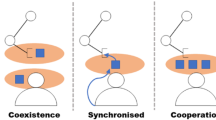Abstract
In research on providing motion assistance for elderly care, the robot walking helper is considered to be able to maintain their vitality. For its practicality, one issue of interest is its feasible path planning for guidance. Inspired by the concept of including human factors for path planning previously proposed, in this paper, we develop such a motion guidance system for the robot walking helper. We first selected the human factors most vital for the elderly and also public via an Internet survey, and then developed a corresponding path planning algorithm and control strategy for its realization. Experiments are conducted to demonstrate the effectiveness of the proposed system. Key contributions of the paper lie on (a) one of the few studies that include human factors into path planning of the robot walking helper and (b) a more thorough consideration on comfort with both physical and psychological factors corresponding to elderly and public preference included.
Similar content being viewed by others
References
Yu, H., Spenko, M., Dubowsky, S.: An adaptive shared control system for an intelligent mobility aid for the elderly autonomous robots. Auton. Robot. 15, 53–66 (2003)
Hirata, Y., Hara, A., Kosuge, K.: Motion control of passive intelligent walker using servo brake. IEEE Trans. on Robotics. 23, 981–990 (2007)
Lacey, G.J., Rodriguez-Losada, D.: The evolution of Guido. IEEE Robot. Autom. Mag. 15, 75–83 (2008)
Ko, C.H., Young, K.Y., Huang, Y.C., Agrawal, S.K.: Active and passive control of walk-assist robot for outdoor guidance. IEEE/ASME Trans. Mechatron. 18, 1211–1220 (2013)
Chik, S.F., Yeong, C.F., Su, E.L.M., Lim, T.Y., Subramaniam, Y., Chin, P.J.H.: A review of social-aware navigation frameworks for service robot in dynamic human environments. J. Telecommunication. 8, 41–50 (2016)
Morales, Y.; Watanabe, A.; Ferreri, F.; Even, J.; Ikeda, T.; Shinozawa, K.; Miyashita, T.; Hagita, N.: Including human factors for planning comfortable paths. In proceedings of the 2015 IEEE international conference on robotics and automation, Seattle, Washington, USA, May 26-30, pp. 6153–6159 (2015)
Patompak, P.; Jeong, S.; Nilkhamhang, I.; Chong, N. Y.: Learning social relations for culture aware interaction. In Proceedings of the 2017 International Conference on Ubiquitous Robots and Ambient Intelligence, Jeju, Korea, June 28–July 1, pp. 26–31 (2017)
Truong, X.-T., Ngo, T.D.: Toward socially aware robot navigation in dynamic and crowded environments: a proactive social motion model. IEEE Trans. Autom. Sci. Eng. 14, 1743–1760 (2017)
Chi, W.; Kono, H.; Tamura, Y.; Yamashita, A.; Asama, H.; Meng, M. Q.-H.: A human-friendly robot navigation algorithm using the risk-RRT approach. In proceedings of the 2016 IEEE international conference on real-time computing and robotics, Angkor Wat, Cambodia, June 6-9, pp. 227–232 (2016)
Bevilacqua, P.; Frego, M.; Bertolazzi, E.; Fontanelli, D.; Palopoli, L.; Biral, F.: Path planning maximising human comfort for assistive robots. In proceedings of the 2016 IEEE conference on control applications, Buenos Aires, Argentina, Sep. 19-22, May 9-13, pp. 1421–1427 (2016)
Park, J. J.; Kuipers, B.: A smooth control law for graceful motion of differential wheeled mobile robots in 2D environment. In Proceedings of the 2011 IEEE International Conference on Robotics and Automation, Shanghai, China, pp. 4896–4902 (2011)
Bianco, C.G.L.: Minimum-jerk velocity planning for mobile robot applications. IEEE Trans. on Robotics. 29, 1317–1326 (2013)
Yin, P.; Xiong, R.; Wu, J.: Real-time generation of a continuous acceleration trajectory for mobile robots. In Proceedings of the 2012 International Conference on Mechatronics and Automation, Chengdu, China, Aug. 5–8, pp. 1168–1173 (2012)
Urbano, J.; Terashima, K.; Miyoshi, T.: Velocity control of an omni-directional wheelchair considering user’s comfort by suppressing vibration. In proceedings of the 2005 IEEE/RSJ international conference on intelligent robots and systems, Edmonton, AB, Canada, Aug 2-6, pp. 3169–3174 (2005)
Lu, D. V.; Hershberger, D.; Smart, W. D.: Layered costmaps for context-sensitive navigation. In Proceedings of the 2014 IEEE/RSJ International Conference on Intelligent Robots and Systems, Chicago, IL, USA, pp. 709–715 (2014)
Ko, C.H., Young, K.Y., Huang, Y.C., Agrawal, S.K.: Walk-assist robot: a novel approach to gain selection of a braking controller using differential flatness. IEEE Trans. Cont. Syst. Technol. 21, 2299–2305 (2013)
Hall, E.T.: The Hidden Dimension. Anchor Books, U.S.A (1990)
Gu, D., Hu, H.: Receding horizon tracking control of wheeled mobile robots. IEEE Trans. Cont. Syst. Technol. 14, 743–749 (2006)
Tutsoy, O.: CPG based RL algorithm learns to control of a humanoid robot leg. Int. J. Robot. Autom. 2, 206–4185 (2015)
Tutsoy, O., Barkana, D.E., Colak, S.: Learning to balance an NAO robot using reinforcement learning with symbolic inverse kinematic. Trans. I. Meas. Control. 39, 1735–1748 (2017)
Auger, F., Hilairet, M., Guerrero, J.M., Monmasson, E., Orlowska-Kowalska, T., Katsura, S.: Industrial applications of the Kalman filter: a review. IEEE Trans. Ind. Elect. 60, 5458–5470 (2013)
Hart, P.E., Nilsson, N.J., Raphael, B.: A formal basis for the heuristic determination of minimum cost paths. IEEE Trans. Syst. Sci. Cyb. 4, 100–107 (1968)
Brooke, J.: SUS - A quick and dirty usability scale. Usability evaluation in industry. CRC Press, Earley, Reading, UK (1996)
Bangor, A., Kortum, P., Miller, J.: Determining what individual SUS scores mean: adding an adjective rating scale. Usability Studies. 4, 114–123 (2009)
Acknowledgments
This work was supported in part by the Ministry of Science and Technology, Taiwan, under Grant MOST 108-2221-E-214-034.
Author information
Authors and Affiliations
Contributions
K.-Y. Young and C.-H. Ko conceived the system and supervised the experiments. S.-L. Cheng contributed to experimental design and performance evaluation. H.-W. Tsou developed the system and conducted the experiments.
Corresponding author
Ethics declarations
Conflict of Interest
The authors declare no conflict of interest.
Rights and permissions
About this article
Cite this article
Young, Ky., Cheng, SL., Ko, CH. et al. Development of a Comfort-Based Motion Guidance System for a Robot Walking Helper. J Intell Robot Syst 100, 379–388 (2020). https://doi.org/10.1007/s10846-020-01168-2
Received:
Accepted:
Published:
Issue Date:
DOI: https://doi.org/10.1007/s10846-020-01168-2




